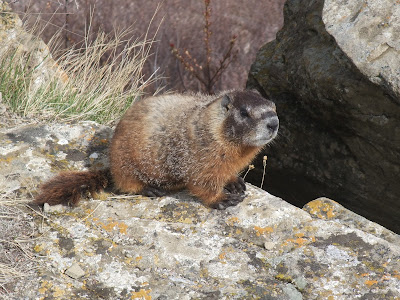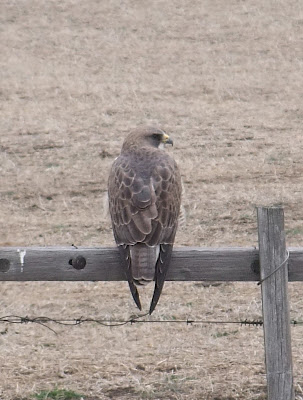 Yes, there is a place with this name, believe it or not!
Yes, there is a place with this name, believe it or not!We were cold overnight and woke to a grey and miserable start to the day by Little Bow Lake so we really didn’t make the most of our stay in the park. We started driving and Simon was back on his best ‘spotter’ form for deer and birds of prey galore on our way.
We admitted to each other that we are feeling a little directionless having spent so long focusing on what we were going to see with the Baileys. Thank goodness for some good recommendations from our Calgary hosts. The World heritage site of Head-smashed-in Buffalo Jump (let’s call it HSIBJ for short from now on!) was one such recommendation.
When we arrived
and grabbed lunch the skies lightened and the clouds broke to reveal some
patches of blue so it was a great time to go for a walk. When Yvette first mentioned this tourist
attraction I was a little unsure – why would we want to see somewhere
celebrating Buffalo getting their heads smashed in?! But I quickly learned that it was more about
educating us on the heritage of the Plains people, known as the Blackfoot, who
used to live here and their methods of hunting the buffalo that they were so reliant
upon. This site was used by the prairie people as a Buffalo jump for about 5700
years, making it one of the oldest and best preserved in existence. You have to admire the ingenuity of this hunting
method they used. In a 15 minute
introductory video we learnt how the prairie hunters used the buffalo’s habits
against themselves as part of their strategy.
They went to great lengths to prepare boundaries made of brush and stone called cairns leading to the cliff edge in order to ‘funnel’ the buffalo towards
their doom. Then, when conditions were
just right, a chosen few hunters donned wolf hides to gradually move the
buffalo into the right area before a young male dressed as a buffalo calf and
feigning distress, drew their attention towards the ledge. When the time was right and the herd was
within the cairns, the rest of the community who were hidden alongside
the cairns would jump up and cause a stampede towards the cliff. By the time
the buffalo at the front realised it was a trap they were forced over the edge
by the momentum of their own kind behind them.
A very effective way to kill many buffalo in one go. The community
relied on an effective hunt to provide food and shelter for their tribes over
the harsh winters. The specific conditions required to make the hunt a success
meant that the buffalo jumps were not an annual event and buffalo were so
numerous back then that their population was unaffected.
Legend has it that the name HSIBJ came from an incident in
the 1800s when a young brave wanted to watch the plunge of the buffalo over the
cliff. Standing under the shelter of a
ledge, he watched the beasts fall past him.
But the hunt was unusually good that day and as the bodies mounted he
became trapped between the animals and the cliff. When his people came to
butcher the buffalo, they found the brave with his skull crushed under the
weight of the carcasses. Hence, they
called the place ‘Head-smashed-in’. So,
you see, it wasn’t about the buffalo having their heads smashed in at all! It’s a good thing that we aren’t so literal
back home in Essex – I know numerous locations where people have had their head
smashed in…. it would just get confusing.
 |
| The ledge of the buffalo jump with the prairie stretching beneath - natural erosion has reduced the height of the drop from the 20 metres it used to be to roughly 10 metres |
 Anyway, as well as the video and a walkway to the cliff edge
itself, the museum was filled with exhibits on six levels down the hill-side. It was all set out in a very
effective manner. The location was placed on the World Heritage list as a site
of outstanding universal value forming part of the cultural heritage of mankind
in 1981.
Anyway, as well as the video and a walkway to the cliff edge
itself, the museum was filled with exhibits on six levels down the hill-side. It was all set out in a very
effective manner. The location was placed on the World Heritage list as a site
of outstanding universal value forming part of the cultural heritage of mankind
in 1981.  |
| Simon helpfully pointing out the buffalo |
 |
| Yellow-bellied marmot |
Having left the museum we then walked the trail to get a view of the jump from below. I enjoyed seeing the surrounding wildlife as ever – yellow-bellied marmots were confidently roaming the cliff edge and Northern Harriers circled overhead.
 | |||||||
| This is a better image than any I attempted to get myself! |
We spent a couple of hours exploring the site before heading
towards our next National Park – Waterton Lakes, about one hour and 15 minutes
away.
 |
| A rare complete rainbow |
 Having left the Rockies behind on
Saturday, it was a pleasure when more ice-capped mountains came into view as we
neared the Park. The location we are camping in at the Townsite is mere
miles away from the US border and Montana, as shown on this map:
Having left the Rockies behind on
Saturday, it was a pleasure when more ice-capped mountains came into view as we
neared the Park. The location we are camping in at the Townsite is mere
miles away from the US border and Montana, as shown on this map: As we entered the park the scenery got even better and we started seeing those red chairs all over the place! This is the view from the red chairs on the edge of our campsite:
 |
| View across Waterton Lake |
 |
| Our site for two days |






No comments:
Post a Comment